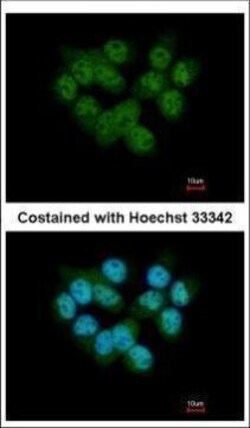Learn More
Invitrogen™ SEPHS2 Polyclonal Antibody


Rabbit Polyclonal Antibody
Supplier: Invitrogen™ PA527950
Description
Recommended positive controls: A431, H1299, HeLa, HepG2. Predicted reactivity: Mouse (96%), Rat (96%), Xenopus laevis (87%), Dog (96%), Pig (95%), Rabbit (96%), Rhesus Monkey (99%), Chimpanzee (100%), Bovine (95%), Guinea pig (95%). Store product as a concentrated solution. Centrifuge briefly prior to opening the vial.
This protein encodes an enzyme that synthesizes selenophosphate from selenide and ATP. Selenophosphate is the selenium donor used to synthesize selenocysteine, which is co-translationally incorporated into selenoproteins at in-frame UGA codons. This protein itself contains a selenocysteine residue in its predicted active site. The 3' UTR of the gene has a stem-loop secondary structure called a selenocysteine insertion sequence (SECIS) element, which allows UGA to direct the incorporation of selenocysteine rather than signal a translational stop.
Specifications
| SEPHS2 | |
| Polyclonal | |
| Unconjugated | |
| SEPHS2 | |
| clone 1000; selenide; selenide, water dikinase 2; Selenium donor protein 2; selenophosphate synthase 2; selenophosphate synthetase 2; Sephs2; Sps2; SPS2b; the SelD gene product; Ysg3 | |
| Rabbit | |
| Antigen affinity chromatography | |
| RUO | |
| 22928 | |
| Store at 4°C short term. For long term storage, store at -20°C, avoiding freeze/thaw cycles. | |
| Liquid |
| Immunohistochemistry (Paraffin), Western Blot, Immunocytochemistry | |
| 0.74 mg/mL | |
| 0.1M tris glycine with 10% glycerol and 0.01% thimerosal; pH 7 | |
| Q99611 | |
| SEPHS2 | |
| Recombinant protein encompassing a sequence within the center region of human SEPHS2. The exact sequence is proprietary. | |
| 100 μL | |
| Primary | |
| Human | |
| Antibody | |
| IgG |
Safety and Handling
Your input is important to us. Please complete this form to provide feedback related to the content on this product.


